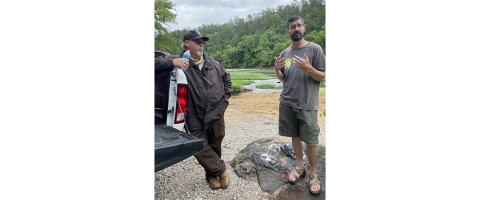West Blocton, Alabama – The crowds swoon over the Cahaba lilies along the Cahaba River in the same-name wildlife refuge. Each spring, they come from nearby Birmingham, Upstate New York, and far-off Canada. The white lilies dot the shoals for a day then disappear only to be replaced by neighboring, equally radiant flowers.
By mid-June, though, the lilies have disappeared. And so too have most of the visitors. Sure, a few, like Johnny West, stick around to fish or swim or picnic. But the Cahaba River National Wildlife Refuge returns to bucolic splendor to await next year’s crop of camera-toting tourists.
“They’ll come down here, take some pictures, and then they’re gone,” says West, 85, a dead ringer for Willie Nelson – everybody calls him that -- with long white hair and requisite headband.
Steven Trull wants to give refuge visitors a reason to stick around. He manages the refuge and, along with a bevy of state, federal and nonprofit partners, envisions year-round recreation at the conservation preserve below fast-growing Birmingham and Tuscaloosa.
The refuge’s future, though, is inextricably linked to its tainted past. Coal mining left a legacy of habitat destruction and polluted waters. The refuge must be cleaned up before it welcomes legions of outdoor enthusiasts. Today, 20 years after the refuge was created, Trull has the money, thanks to Alabama’s Abandoned Mine Land Reclamation program, to do just that.
“When we acquired the land, we acquired a problem,” Trull says from a viewing platform high atop the river’s western edge. “Being able to clean it up and stop the chemicals from going into the Cahaba River is a wonderful thing on so many levels. We’ve got a lot of opportunities to increase public access.”
An ecological marvel
N.H. Thompson and his sons left Mississippi during the Civil War to mine coal in what’s today the northern tier of the Cahaba refuge. Their slave-labored coal seams attracted prospectors who fueled the iron and steel mills in burgeoning Birmingham in the 1880s. Oliver Hazzard Perry Piper, one of the owners of the Little Cahaba Coal Company, opened two mines at the turn of the century and established the town of Piper within the boundaries of the current refuge.
Piper’s history mirrors the nation’s fraught relationship with King Coal. A town grew up and hundreds of men went down into the pits. An explosion at Piper No. 2 killed a dozen men in 1906. A half dozen were asphyxiated in the mine twenty years later. The United Mine Workers Union organized a strike in 1934 that led the Alabama National Guard to occupy the town. The underground mines shut down and attempts at surface mining lasted until the 1980s. Industrial timber companies claimed the land and planted rows of loblolly pine. A coal spoil site and a polluted pond is about all that remains of the Piper mines.
“I worked in those mines for 23 years, underground, three- to four-hundred feet straight down,” West says, pointing across the river to the where the No. 2 Piper stood. “There’s mines all in back of those woods. I know where they all are.”
West, who lives in West Blocton, has been coming to the Cahaba since he was a boy. The river’s in his blood. He’s the Cahaba’s unofficial, yet highly prized, custodian and watchdog, fishing it daily for catfish, drum, and bass, and picking up the trash others leave behind. The annual Cahaba Lily Festival was the previous Saturday and West and others estimated maybe 1,000 cars.
The Cahaba River is an ecological marvel in a state whose rivers have been dammed up, dumped upon, and badly degraded. It flows from springs and seeps northeast of Birmingham 190 miles to the Alabama River. The refuge sits about midway. Nearly three-fourths of the river is free-flowing, the longest stretch of unimpeded river in Alabama. Beyond Birmingham, the Cahaba runs through the rolling hills that mark the end of the Appalachian Mountain chain. The rocky shoals along the river’s upper reaches, and the relative lack of riverside development, fuel the river’s bounteous biodiversity.
A sign at the overlook boasts that no other similarly sized river in North America is home to as many fish species as the Cahaba. Fifty of the continent’s 300 types of mussels are found in the river, according to the refuge’s 2015 conservation plan. And roughly 10 percent of North America’s gill-breathing freshwater snail species call the Cahaba home.
And then there’s the Cahaba lily, or shoal lily, or shoals spider-lily, the rare, though not federally threatened or endangered, flower that prompted 18th century naturalist William Bartram to gush that “nothing in vegetable nature was more pleasing.” The perennials require swift-moving waters, rocky shoals, and much sunlight. The white blooms grow to three inches wide with six petals. Their nectar attracts pollinators. Georgia and the Carolinas also lay claim to Hymenocallis coronaria.
A few lily-lovers, with poles for balance and cameras for memories, step gingerly through the carpet of white blooms and slick rocks in the middle of the Cahaba one recent afternoon. It’s off-and-on raining, but the splendor of the scenery douses any complaints. David Butler and fellow lily fans had spent the previous Saturday plopping lily bulbs into the top end of the shoals so they’d, hopefully, lodge into a crevice and take root. Butler is the Cahaba Riverkeeper in charge of monitoring water quality, organizing cleanups, and boosting the river’s profile.
“It is the most biodiverse river in Alabama, yet people don’t appreciate it,” he says. “The water quality is a function of what’s going on up in Birmingham. The closer you get to Birmingham, the worse it gets. The water quality down here is, generally, very good, although there’s more of an impact from logging and land disturbance now than ever before.”
The Cahaba supplies water to Birmingham, and takes some of its municipal and industrial wastewater in return. In all, nine wastewater treatment plants use the river between Birmingham and the refuge. Failing septic tanks, residential and industrial development, agricultural runoff, and loss of bottomland hardwoods contribute to the Cahaba’s water-quality woes. Add in the pollution from the abandoned mining operations – heavy metals, toxic chemicals, sedimentation – and the river is under siege.
Today, three mussel species are listed as federally threatened or endangered. Two fish species, the goldline darter and the Cahaba shiner, are listed as threatened or endangered, respectively. Thirty-seven types of plants in the river’s watershed are vulnerable, imperiled, or critically imperiled, including the Cahaba lily.
New land, clean water
In 2021, the Service bought 1,164 acres of well-tended forest on the river’s eastern bank. The Nature Conservancy (TNC) restored the cut-over land with acres of longleaf pine trees. The forest was burned every few years to enhance habitats favored by rare species.
Fittingly, the $3.2 million spent for the property came from the Land and Water Conservation Fund which parlays revenues from offshore oil and gas leases into conservation and recreation projects. The refuge, today, contains nearly 5,000 acres with two-thirds on the river’s western side. The state of Alabama has secured more mine-reclamation money -- $5 million -- to continue cleaning up the mine’s waste. And the refuge, with partners, will spend another $735,000 to reduce woody undergrowth, help prevent wildfires, and benefit the native plants and longleaf pines.
“It’s got hunting access, new trails, canoeing, kayaking, fishing, wildlife observation – all sorts of recreation opportunities for the community,” Trull says. “But we also have to clean up the environment. Being able to fix the pond and stop all kinds of chemicals from going into the Cahaba River is a wonderful thing on so many levels.”
A beaver pond below the now-sealed Piper mines remains contaminated by sulfuric acid runoff that leached out and washed downhill. The state’s Abandoned Mine Land reclamation agency has already capped the pits and cleaned up some of the toxic mess. Now, it’ll clean up the rest and help restore the refuge to its natural state. They’ll build a limestone check dam and a half-mile-long limestone spillway to filter contaminated water on its way to the Cahaba River. The bigger dam will allow for more fishing. New trails too will be built.
“The lilies may be the main attraction for the refuge,” says Butler, the Riverkeeper, “but there is so much more to do here.”






